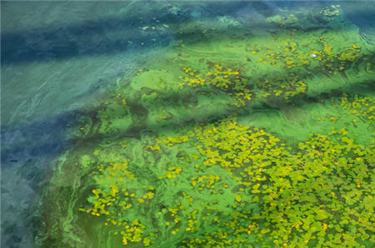EPA Researchers Analyze 30 Years Of Data To Understand How Warming Temperatures Will Affect Harmful Algal Blooms In Reservoirs
By U.S. EPA

Harmful algal blooms in lakes can produce odorous, scum-covered, or discolored water, and negatively impact human health and the environment. These blooms are frequently formed by cyanobacteria, which are often found floating in lakes as a type of phytoplankton. Phytoplankton are microscopic organisms that use sunlight to make their own food and are important food sources for other organisms. Many species of cyanobacteria thrive in warm, nutrient-rich environments and some can produce toxins that cause health problems for humans, pets, and wildlife. Climate change and ongoing nutrient pollution may cause more frequent and intense cyanobacterial blooms in the future.
While these blooms seem to have become more frequent and widespread, there is limited historical monitoring data showing the rate and severity of the increase. To address this issue, EPA scientists collaborated with U.S. Army Corps of Engineers to compile and analyze over 30 years of monitoring data from 20 U.S. reservoirs (human-made lakes) located in Indiana, Kentucky, and Ohio.
“Long-term datasets like this one not only give us an uncommon opportunity to directly see how, and potentially why, lakes have changed over time, but they also provide valuable information that can be used to help inform expectations, decisions, and management practices that seek to improve and protect aquatic resources and ecosystems in the future,” said EPA scientist Nathan Smucker, who led the research.
Based on data from these reservoirs, the scientists found that cyanobacteria cell densities, including those capable of producing toxins, have rapidly increased since 2005 with blooms quickly becoming recurrent problems within the span of a decade. By 2018, all 20 reservoirs – including ones with the most forested watersheds – had experienced blooms that posed potentially high risk to human health, based on World Health Organization recommendations. They also found evidence of possible causes contributing to these increasingly severe blooms.
The scientists found no clear or consistent changes in land use, precipitation, and nutrient concentrations among these reservoirs, but they did find that reservoirs are heating up earlier in the year and remaining warm longer than they did 30 years ago. While blooms increased in all 20 reservoirs, the reservoirs with urban or agriculturally dominated watersheds had the greatest increases, suggesting that the effects of warming and changes in seasonality become stronger in reservoirs with more nutrient runoff.
These results support predictions that longer durations of warmer temperatures, which can be associated with greater water column stability, favor cyanobacteria and contribute to more severe blooms. The earlier warming of surface waters also corresponded with earlier seasonal decreases in dissolved oxygen concentrations in deep waters. This decrease in dissolved oxygen is a sign that stratification, which is when cooler deep water becomes isolated from warmer surface water, is beginning earlier in the year in reservoirs where this occurs.
A consequence of this earlier warming and stratification is that the duration and severity of deep water hypoxia in reservoirs with greater amounts of agriculture in their watersheds now lasts two months longer, on average, than it did at the beginning of the study period. These longer and more severe durations of low oxygen can contribute to other problems, such as greater methane production – a potent greenhouse gas – and greater amounts of legacy nutrients being released from lake sediments.
In lakes where stratification does not occur and in those with occasional breakdowns in stratification, these deep water nutrients can be transported to the surface and possibly further fuel and sustain blooms. When blooms end, they decompose and can lead to more oxygen depletion. In the fall when stratification ends and the water column mixes, oxygen concentrations can get low enough to cause fish kills, which occasionally have been observed in some of these reservoirs.
This research highlights how changes in seasonality, warming water temperatures, and nutrients can contribute to worsening cyanobacterial blooms in these reservoirs and the potential problems they pose to ecosystems and to human health and wellbeing. It is also important to keep in mind that while algal blooms are increasing in some regions, they are not necessarily increasing everywhere, and they are even improving in some locations.
“While climate-related changes may be difficult to mitigate in the near term, excess nutrient runoff from watersheds can potentially be reduced through more strategic conservation practices, more effective non-point source pollution mitigation programs, and establishing appropriate targets for nutrients in the streams and rivers draining to reservoirs, all of which directly link to harmful algal bloom ecology,” said EPA scientist Christopher Nietch.
Going forward, Nathan Smucker and Chris Nietch will continue using this dataset by combining it with satellite derived remote sensing data. They hope this combined analysis will help determine bloom frequency, magnitude, and coverage within reservoirs and improve interpretations from multiple sources of remote sensing data. Additionally, cross-regional efforts are underway throughout EPA to build more expansive and thorough cyanobacteria datasets and monitoring tools.
Learn more:
Cyanobacterial Harmful Algal Blooms (CyanoHABs) in Water Bodies
Related articles:
DNA metabarcoding effectively quantifies diatom responses to nutrients in streams
Widespread global increase in intense lake phytoplankton blooms since the 1980s
Unexpected stasis in a changing world: Lake nutrient and chlorophyll trends since 1990
Widespread deoxygenation of temperate lakes
Climate change drives widespread shifts in lake thermal habitat
